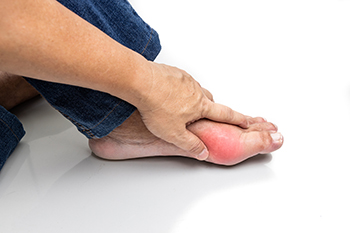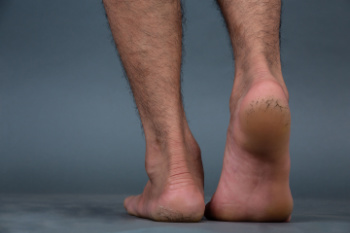Connect With Us
Blog

Pain in the big toe can be a sign of gout, a type of arthritis caused by the buildup of uric acid crystals within the joint. When this acid accumulates faster than the body can eliminate it, sharp crystals form around the base of the big toe, known as the metatarsophalangeal, or MTP, joint. A gout flare-up often appears suddenly, producing intense pain, swelling, redness, and warmth in the MTP joint. It can become so tender that even light contact from a bedsheet feels painful. Repeated episodes can damage joint tissues and lead to visible lumps called tophi, which form beneath the skin near the toe or ankle. A podiatrist can examine your foot, order imaging tests or joint fluid analysis, and recommend a treatment plan to reduce pain and protect long-term joint health. If you have flare-ups of big toe pain, it is suggested that you schedule an appointment with a podiatrist for a diagnosis and appropriate treatment options.
Gout is a foot condition that requires certain treatment and care. If you are seeking treatment, contact David Carmack, DPM from Texas. Our doctor will treat your foot and ankle needs.
What Is Gout?
Gout is a type of arthritis caused by a buildup of uric acid in the bloodstream. It often develops in the foot, especially the big toe area, although it can manifest in other parts of the body as well. Gout can make walking and standing very painful and is especially common in diabetics and the obese.
People typically get gout because of a poor diet. Genetic predisposition is also a factor. The children of parents who have had gout frequently have a chance of developing it themselves.
Gout can easily be identified by redness and inflammation of the big toe and the surrounding areas of the foot. Other symptoms include extreme fatigue, joint pain, and running high fevers. Sometimes corticosteroid drugs can be prescribed to treat gout, but the best way to combat this disease is to get more exercise and eat a better diet.
If you have any questions, please feel free to contact our office located in Marble Falls, TX . We offer the newest diagnostic and treatment technologies for all your foot care needs.

Toe surgery is sometimes needed when deformities or painful changes in the toes make walking, standing, or wearing shoes difficult. Conditions like hammer toes, claw toes, or severe bunions may cause joints to bend abnormally, leading to corns, ulcers, or painful pressure points. These problems may be present at birth or develop later due to arthritis, high arches, or changes in foot mechanics. When the toe becomes rigid, conservative measures may no longer help, and toe surgery may be required to restore function. A podiatrist can determine whether procedures such as joint realignment, tendon release, bone removal, or fusion are appropriate. In some cases, correction also involves the metatarsal bones of the forefoot to achieve better balance and reduce strain. Surgery can relieve discomfort, improve alignment, and lower the risk of more serious complications. If you are experiencing ongoing toe pain, it is suggested that you make an appointment with a podiatrist for an exam and treatment.
Toe pain can disrupt your daily activities. If you have any concerns, contact David Carmack, DPM of Texas. Our doctor can provide the care you need to keep you pain-free and on your feet.
What Causes Toe Pain?
Most severe toe pain is caused due to a sports injury, trauma from dropping something heavy on the toe, or bumping into something rigid. Other problems can develop over time for various reasons.
Toe pain can be caused by one or more ailments. The most common include:
- Trauma
- Sports injury
- Wearing shoes that are too tight
- Arthritis
- Gout
- Corns and calluses
- Hammertoe
- Bunions
- Blisters
- Ingrown toenails
- Sprains
- Fractures (broken bones)
- Dislocations
When to See a Podiatrist
- Severe pain
- Persistent pain that lasts more than a week
- Signs of infection
- Continued swelling
- Pain that prevents walking
Diagnosis
In many cases the cause of toe pain is obvious, but in others, a podiatrist may want to use more advanced methods to determine the problem. These can range from simple visual inspections and sensation tests to X-rays and MRI scans. Prior medical history, family medical history, and any recent physical traumatic events will all be taken into consideration for a proper diagnosis.
Treatment
Treatments for toe pain and injuries vary and may include shoe inserts, padding, taping, medicines, injections, and in some cases, surgery. If you believe that you have broken a toe, please see a podiatrist as soon as possible.
If you have any questions please contact our office located in Marble Falls, TX . We offer the newest diagnostic and treatment technologies for all your foot and ankle needs.

Heel fissures, or cracks in the skin around the heel, are a common problem that can cause pain and bleeding if left untreated. They often develop when the skin becomes dry, thick, or callused, and the pressure from walking causes it to split. Standing for long hours, wearing open-back shoes, being overweight, or having skin conditions such as eczema can make heel fissures worse. Treatment typically involves softening and moisturizing the skin with thick emollient creams or heel balms that contain urea or lactic acid. Having hard skin removed, and, in severe cases, having the heels bandaged can help. If heel fissures are painful, deep, or showing signs of infection, it is suggested that you see a podiatrist for an evaluation and professional care, which may include prescribed medication for relief.
If the skin on your feet starts to crack, you may want to see a podiatrist to find treatment. If you have any concerns, contact David Carmack, DPM from Texas. Our doctor can provide the care you need to keep you pain-free and on your feet.
Cracked Heels
It is important to moisturize your cracked heels in order to prevent pain, bleeding, and infection. The reason cracked heels form is because the skin on the foot is too dry to support the immense pressure placed on them. When the foot expands, the dry skin on the foot begins to split.
Ways to Help Heal Them
- Invest in a good foot cream
- Try Using Petroleum Jelly
- Ease up on Soaps
- Drink Plenty of Water
Ways to Prevent Cracked Heels
- Moisturize After Showering
- Skip a Shower
- Keep Shower Water Lukewarm
- Don’t Scrub Your Feet
If you are unsure how to proceed in treating cracked heels, seek guidance from a podiatrist. Your doctor will help you with any questions or information you may need.
If you have any questions, please feel free to contact our office located in Marble Falls, TX . We offer the newest diagnostic and treatment technologies for all your foot care needs.

External fixators play a vital role in treating ankle and foot injuries by providing stability from a biomechanical perspective. External fixators are special devices that help treat serious ankle and foot injuries. They work like an outside frame, using pins and rods to keep broken bones steady and in the right position. By holding the bones still, the fixator takes pressure off the injured area, prevents harmful movement, and gives the foot a better chance to heal. This support also helps keep the joints balanced so patients can move more normally once recovery begins. A podiatrist carefully places the fixator and monitors the healing process. They guide rehabilitation to restore strength, flexibility, and mobility while lowering the risk of problems. With this expert care, patients can safely return to daily activities with more confidence. If you are dealing with an ankle or foot injury, it is suggested that you see a podiatrist to find out if external fixation is the right treatment for you.
Foot surgery is sometimes necessary to treat a foot ailment. To learn more, contact David Carmack, DPM of Texas. Our doctor will assist you with all of your foot and ankle needs.
When Is Surgery Necessary?
Foot and ankle surgery is generally reserved for cases in which less invasive, conservative procedures have failed to alleviate the problem. Some of the cases in which surgery may be necessary include:
- Removing foot deformities like bunions and bone spurs
- Severe arthritis that has caused bone issues
- Cosmetic reconstruction
What Types of Surgery Are There?
The type of surgery you receive will depend on the nature of the problem you have. Some of the possible surgeries include:
- Bunionectomy for painful bunions
- Surgical fusion for realignment of bones
- Neuropathy decompression surgery to treat nerve damage
Benefits of Surgery
Although surgery is usually a last resort, it can provide more complete pain relief compared to non-surgical methods and may allow you to finally resume full activity.
Surgical techniques have also become increasingly sophisticated. Techniques like endoscopic surgery allow for smaller incisions and faster recovery times.
If you have any questions, please feel free to contact our office located in Marble Falls, TX . We offer the newest diagnostic and treatment technologies for all your foot care needs.
Blog Archives
- December 2025
- November 2025
- October 2025
- September 2025
- August 2025
- July 2025
- June 2025
- May 2025
- April 2025
- March 2025
- February 2025
- January 2025
- December 2024
- November 2024
- October 2024
- September 2024
- August 2024
- July 2024
- June 2024
- May 2024
- April 2024
- March 2024
- February 2024
- January 2024
- December 2023
- November 2023
- October 2023
- September 2023
- August 2023
- July 2023
- June 2023
- May 2023
- April 2023
- March 2023
- February 2023
- January 2023
- December 2022
- November 2022
- October 2022
- September 2022
- August 2022
- July 2022
- June 2022
- May 2022
